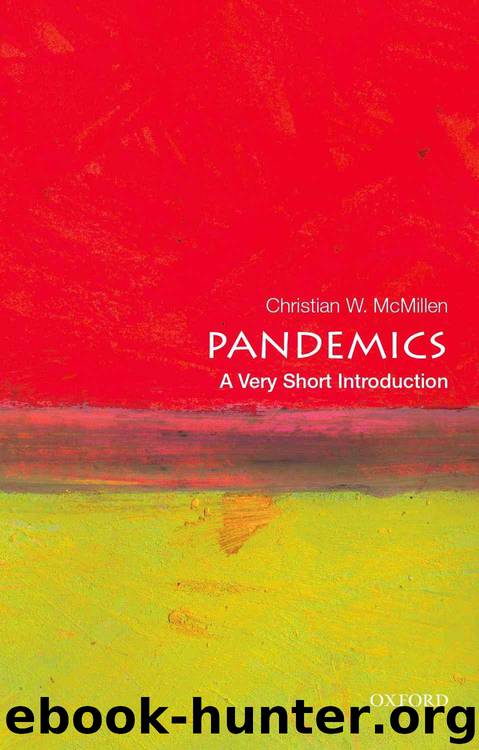Pandemics: A Very Short Introduction (Very Short Introductions) by McMillen Christian W

Author:McMillen, Christian W. [McMillen, Christian W.]
Language: eng
Format: azw3
ISBN: 9780199340095
Publisher: Oxford University Press
Published: 2016-10-31T16:00:00+00:00
Chapter 5
Tuberculosis
Tuberculosis, caused by Mycobacterium tuberculosis, might be the oldest human disease. It is part of a family of mycobacterial diseases, including M. africanum, M. bovis, and M. cannetti, that have been evolving for perhaps three hundred million years. The oldest fossil evidence for a tuberculosis-like disease comes from a five-hundred-thousand-year-old Homo erectus skull found in Turkey with TB-like lesions. M. tuberculosis—the type that affects humans—emerged in Africa about seventy thousand years ago. It accompanied modern humans on their migratory paths out of Africa, first across the Indian Ocean and then, some millennia later, into Eurasia. TB flourished when people settled down and began living together about ten thousand years ago. It has been with us ever since.
Tuberculosis affects almost all parts of the body—the bones, the blood, the brain. Its most common and deadly form, carried in tiny droplets through the air from person to person and highly infectious, is pulmonary tuberculosis. It thrives in densely packed places.
Like plague, it is an ancient disease and has been written about for nearly as long. Tuberculosis was also discussed in terms of contagion and miasma. Retrospective diagnosis is tough. TB can look like pneumonia or other respiratory ailments. Centuries-old descriptions of its symptoms—night sweats, weight loss, hacking cough—make definitive diagnoses difficult. TB was the disease that ushered in the laboratory revolution, for it was the mycobacteria that causes the disease that Robert Koch discovered under his microscope in 1882. A disease once known as consumption and phthisis, with unknown but likely myriad causes, became a single disease—tuberculosis—caused by a single entity.
TB did not rise up and suddenly snuff the life out of millions like plague; it worked slowly. No one thought it the wrath of God, divinely sent to rout sin and sinners. Unlike cholera, its symptoms are not especially dramatic. One is not suddenly overwhelmed with TB, dead or alive in a matter of hours after disgorging one’s bodily fluids. TB works insidiously, initially unseen. TB did not inflame the press and public like cholera did in the nineteenth century, nor did it arouse people to massacre others as plague did. Yet TB was responsible for far more death than either of these diseases. As early as the seventeenth century, the Bills of Mortality—the early epidemiological records from London—indicate that 20 percent of deaths in the city were due to consumption.
The ways people once understood TB were quite different than how it is now understood. Richard Morton’s comprehensive Phthisiologia, published first in Latin and then in English at the end of the seventeenth century, considered consumption in all its many forms. For instance, to Morton TB could variously occur when people swallowed nails and punctured their lungs or when women expended too much breast milk and taxed their blood, leading to a weak, phlegmatic condition. While these do not sound like modern TB, when Morton talks about the tubercles, those knotty swellings in the lungs, his descriptions sound similar to the disease we now call tuberculosis. Thomas Sydenham thought long journeys on horseback were the soundest medicine.
Download
This site does not store any files on its server. We only index and link to content provided by other sites. Please contact the content providers to delete copyright contents if any and email us, we'll remove relevant links or contents immediately.
Periodization Training for Sports by Tudor Bompa(8170)
Why We Sleep: Unlocking the Power of Sleep and Dreams by Matthew Walker(6618)
Paper Towns by Green John(5091)
The Immortal Life of Henrietta Lacks by Rebecca Skloot(4525)
The Sports Rules Book by Human Kinetics(4294)
Dynamic Alignment Through Imagery by Eric Franklin(4118)
ACSM's Complete Guide to Fitness & Health by ACSM(3989)
Kaplan MCAT Organic Chemistry Review: Created for MCAT 2015 (Kaplan Test Prep) by Kaplan(3940)
Introduction to Kinesiology by Shirl J. Hoffman(3726)
Livewired by David Eagleman(3684)
The Death of the Heart by Elizabeth Bowen(3552)
The River of Consciousness by Oliver Sacks(3541)
Alchemy and Alchemists by C. J. S. Thompson(3451)
Bad Pharma by Ben Goldacre(3357)
Descartes' Error by Antonio Damasio(3230)
The Emperor of All Maladies: A Biography of Cancer by Siddhartha Mukherjee(3066)
The Gene: An Intimate History by Siddhartha Mukherjee(3047)
The Fate of Rome: Climate, Disease, and the End of an Empire (The Princeton History of the Ancient World) by Kyle Harper(3003)
Kaplan MCAT Behavioral Sciences Review: Created for MCAT 2015 (Kaplan Test Prep) by Kaplan(2940)
